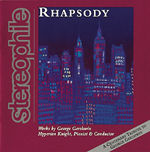| Columns Retired Columns & Blogs |
Editor's Choice: Stereophile's Sampler & Test CD Tracks 12-14
[12-14] Gershwin: Three Preludes, arr. Joe Cea (from Rhapsody, STPH010-2)
Performers: Hyperion Knight, piano; Krzysztof Zimowski, Anthony Templeton, Carol Swift-Matton, Linda Anderson, violins; Katherine Reynolds, Christine Johnson Rancier, violas; Joan Zucker, cello; Jean-Luc Matton, double bass; Robert Dorer, trumpet; Debra Taylor, trombone; Tia Perdomo, clarinet; Lori Lovato, bass clarinet; Jeff Cornelius, Steven Kimple, percussion
Recording Venue: First United Methodist Church, Albuquerque, New Mexico
Recording Date: March 10, 1997
Producers: Hyperion Knight & John Atkinson
Assistant Engineers: Wes Phillips & Steven K. Lee
Executive Producer: Gretchen Grogan
Musician Liaison: Christine Johnson Rancier
Piano Technician: Charles Rempel
Steinway D piano supplied by Barbara Riordan, Washburn Piano Company, Albuquerque, New Mexico
Microphones: two DPA 4012 high-voltage ½" cardioids (ORTF pair); two DPA 4003 high-voltage ½" omnis (spaced pair)
Mike Preamps: two Millennia Media HV-3Bs
A/D converters: dCS 900D (24-bit, 4012s), Manley (20-bit, 4003s) at 44.1kHz
Recorder: Nagra-D
Mixer: Sonic Solutions Digital Audio Workstation (4 channels)
24-16-bit Noiseshaping: Meridian 518
 Although circumstances dictated that I use multimiking on the Mozart Piano Quartet movement (track 5), the relationship between the sound of an orchestra—or even the sound of a solo instrument such as the piano—and the hall in which it plays is such that you cannot chop it into small pieces, then expect to put it all back together again with any predictable degree of success. The promise of purist miking is that if you can preserve that relationship, the recording will not only re-create the sonic image of the musicians, but also the feeling that the listener is actually in the hall where the performance took place. That is what I tried to achieve in my 1997 Gershwin CD, from which these three Preludes are excerpted, made possible by the supportive acoustic of the Albuquerque church in which we recorded them.
Although circumstances dictated that I use multimiking on the Mozart Piano Quartet movement (track 5), the relationship between the sound of an orchestra—or even the sound of a solo instrument such as the piano—and the hall in which it plays is such that you cannot chop it into small pieces, then expect to put it all back together again with any predictable degree of success. The promise of purist miking is that if you can preserve that relationship, the recording will not only re-create the sonic image of the musicians, but also the feeling that the listener is actually in the hall where the performance took place. That is what I tried to achieve in my 1997 Gershwin CD, from which these three Preludes are excerpted, made possible by the supportive acoustic of the Albuquerque church in which we recorded them.
What you should hear: Joe Cea's orchestrations remain close to Gershwin's original conception of these works for solo piano, but are enlivened with bluesy instrumentation. Hyperion conducted the orchestra from the piano for these sessions, so we arranged the instrument with him sitting with his back to the mikes and its lid off so the musicians could hear him. The piano is therefore lighter in balance than it is in the Liszt recording made in the same hall (track 16), and the treble notes should appear to come from the right, not the left.
The miking gave great delicacy of imaging, with individual instrumental images, the sonic objects within the soundstage being reproduced free from bloat. The solo cello and muted trumpet in the second Prelude, for example, are as acoustically "small" as they were in real life. And despite the chamber ensemble scoring, the dynamic range of these tracks is extreme, with the real thing's light and shade faithfully preserved.
- Log in or register to post comments




































